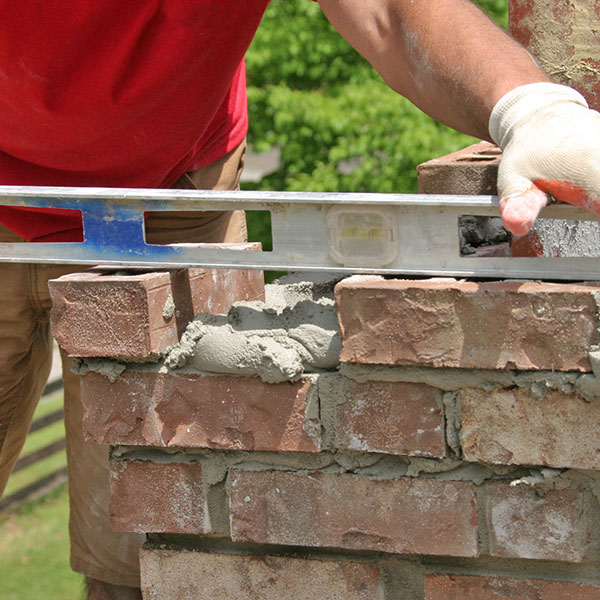Causes of Leaky Chimneys & How to Solve Them
Chimney leaks are the most common problem that fireplace owners face. Water that gets in through your chimney can cause hundreds to thousands of dollars in damages. It can also increase your risk of carbon monoxide exposure or a chimney fire. Moisture in your chimney can crack the chimney lining, allowing carbon monoxide and sparks to escape on top of damaging nearby walls, ceilings, and flooring.
 Identifying the cause of the leak is the best way to find a solution. That’s why we’ve put together this list for you of the top cause of chimney leaks and how to fix them.
Identifying the cause of the leak is the best way to find a solution. That’s why we’ve put together this list for you of the top cause of chimney leaks and how to fix them.
Precipitation Falling through the Chimney Mouth
This is the number one cause of chimney leaks in homes without a chimney cap. If your chimney doesn’t have a cap on it, rain and snow can freely fall down your chimney. You may not realize how much moisture is getting in because the damper, or vent, inside your chimney usually prevents it from falling into the firebox. While the damper keeps your firebox dry, the rest of the chimney may be suffering from water damage. Water can warp and damage your chimney liner or seep through the liner into the bricks, walls, and ceilings around the chimney. This can also create a breeding ground for mold in your chimney.
Solution:
Invest in a chimney cap. A chimney cap acts as an umbrella. It sits over the mouth of the chimney preventing water from freely falling down the chimney. It also has mesh around the sides that stops critters from getting into your chimney while still allowing smoke to escape.
Broken or Missing Chimney Flashing
Have you noticed strips of metal on the roof around the chimney? That’s chimney flashing. It is a strip of material, usually aluminum, that covers the gap between the chimney and the roof. If you’ve noticed water damage in your attic or ceiling around the chimney, missing flashing or damaged flashing is most likely the cause. There is a large gap between the chimney and the roof. If it is not covered, a lot of rain can fall through the space damage ceilings, walls, and structural beams.
Solution:
Have a professional chimney technician repair the chimney flashing. Installing flashing properly is more complicated than it may seem. Chimney technicians have the knowledge and experience to install it correctly.
Condensation Problems
When wood and gas burn, the fumes can have a lot of moisture in them. If this condensation can’t escape, it can accumulate in your chimney. Condensation can be just as harmful to your chimney as rainwater over time. Condensation problems can be caused by many different chimney issues from the wrong size of chimney liner to incorrect waterproofing sealant.
Solution:
If you have noticed that the walls or ceilings around your chimney are damp but you don’t know the cause, it could be condensation. Call a professional chimney sweep and ask for a chimney inspection! A certified chimney sweep will thoroughly investigate the problem to find out why condensation is accumulating in your chimney.
 Untreated Masonry
Untreated Masonry
Bricks and mortar are naturally absorbent. They can act like a sponge, sucking up moisture through the chimney’ surface. When the moisture inside the masonry freezes and thaws, it causes it to breakdown. This can eventually result in serious structural damage to your chimney. Chimneys that are treated with a waterproofing sealant don’t have this problem.
Solution:
Hire a professional chimney sweep to do a Masonry Absorption Test (MAT). This test records how quickly masonry absorbs water. The results will let you know if your chimney needs to be waterproofed. If it does, have your chimney professionally waterproofed. If you decide to tackle this as a DIY project, be sure that you choose a waterproofing sealant that’s designed for chimneys. A waterproofing sealant that isn’t designed for a chimney, especially if it is silicone-based, will trap condensation inside your chimney. This will create another moisture problem in your chimney. Chimney waterproofing sealants are designed to release condensation while preventing precipitation from being absorbed.
Cracked Chimney Crown
The cement block around the top of the chimney is the crown. It is designed to prevent water from being able to seep into the masonry around the mouth of the chimney. If it develops cracks through wear and tear or damage from the elements, water can slip through and begin to saturate the masonry.
Solution:
What you should do to fix a cracked crown depends on the extent of the damage. A chimney professional may recommend a coating to fill in the cracks or a new crown depending on how serious the cracks are. It is a good idea to have the chimney crown inspected by professional
Many times, the only way to determine the cause of a chimney leak is a chimney inspection. Professional chimney sweeps have the equipment and training to closely examine your chimney and correctly identify the cause. This step is crucial to prevent serious damage to your chimney system and home. If you notice water spots in your fireplace or water damage around the chimney, give Guardian Chimney Sweep a call to set up an inspection! Our chimney technicians are trusted by homeowners throughout Houston, Texas! Check out what they are saying for yourself!

 Tap to Call Now
Tap to Call Now